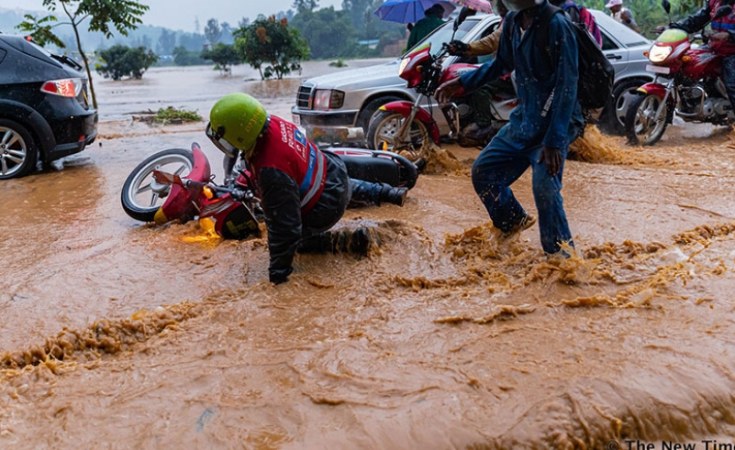Despite having ample water resources, Rwanda faces a significant challenge in terms of water storage capacity, as revealed by a recent report from the Rwanda Water Resources Board.
The report, released on Monday, September 26, says that inadequate storage leaves farmers vulnerable to the vagaries of weather as they are heavily reliant on rain-fed subsistence agriculture.
The lack of storage infrastructure means farmers have limited ability to cope with droughts and floods. These limitations are estimated to cost the economy one-third of its growth potential.
The report highlights six dam projects in the pipeline that could help address the water crisis for irrigation, drinking water and electricity generation.
Bakokwe Dam
Bakokwe Dam will help implement the planned Kagaga water supply system to increase access to clean water in some sectors of Muhanga, Kamonyi, and Ruhango districts according to the report.
The dam is 16 metres high and is, therefore, classified as a large dam under the International Commission on Large Dams classification.
The proposed project covers an area of 594.5 square kilometres with about 394,639 people as of 2020.
The dam will be on Bakowe River, just downstream of the confluence between Kagaga River and Makurungwe River in Muhanga District. The water supply system from the facility comprises a water treatment system, storage tanks, and distribution systems.
Warufu Dam
Warufu Dam is located in Gatsibo District. The reservoir must have a total volume of 25 million cubic metres to irrigate 2,500 hectares along with the clean water supply to Nyagahanga, Ngarama, and Gatsibo sectors.
Developing fisheries in the dam will also increase food security and help the population with a better income. The dam height from ground level is 19.9 metres.
Rusizi III Dam
Ruzizi III is a 147MW hydropower project being developed on the Ruzizi River. It flows along the borders of the DR Congo, Burundi, and Rwanda. The project entails the construction of a run-of-river dam and a power distribution station.
Burundi's current total capacity will double, while Rwanda's will increase by half. It is the first privately financed project in sub-Saharan Africa that will utilise a common regional water resource to generate power that will be shared equally among the three countries.
The project is supported by the World Bank, EU, and AfDB, among others, with an expected investment capital of $450 million. It is expected to be completed by 2024.
The power output will be shared among the three partner states with Rwanda getting 47MW and the rest being shared between Burundi and DR Congo. It will also reduce the local communities' dependence on wood fuel and charcoal; a major threat to the countries' forests and biodiversity.
Akanyaru Multipurpose Dam
The proposed Akanyaru dam project in Gisagara District is situated on Akanyaru River at the border between Rwanda's Southern Province and Burundi's Ngozi Province. Akanyaru River is part of the Kagera River basin that forms part of the Lake Victoria basin.
Akanyaru Multipurpose Dam is designed for power generation, water supply, and irrigation purposes. It is under the Nile Basin Initiative for shared benefits of Burundi and Rwanda.
The project envisages a 52-meter-high dam with a water storage capacity of 333 million cubic metres.
It is expected to generate 14.5 MW of hydropower to supply energy to about 141,111 households with 846,000 people. The dam will irrigate 12,474 hectares supporting 24,948 farmers, provide food for about 124,740 people, and supply water to 614,200 people from the two countries. The project also includes restoration of degraded watersheds upstream of the dam.
Muvumba Multipurpose Dam
The Government of Rwanda received financing from the African Development Bank for the Muvumba Multipurpose Water Resources Development Programme (MMWRDP).
The programme is being implemented in Nyagatare District by Rwanda Water Resources Board.
The planned Muvumba Multipurpose Dam is expected to secure stable water resources for agricultural, hydropower, and domestic water supply in the district and in particular, provide water supply for Nyagatare, Karangazi, and Rwimiyaga sectors, and water for irrigation and livestock in Musheri, Rwempasha, Tabagwe, Nyagatare, Rukomo, Rwimiyaga, and Gatunda sectors.
The proposed dam will have a height of 39 meters and gross storage of 54.77 million cubic metres.
The command area of the irrigation scheme is estimated at 8,820 hectares.
Nyabarongo II Multipurpose Dam
Nyabarongo II Multipurpose Dam is under construction across Nyabarongo River in Rwanda in the boundaries between Northern and Southern Provinces, specifically between Kamonyi and Gakenke Districts.
The dam will measure 59 metres high and 363 metres long, creating a reservoir with a storage capacity of 803,000,000 cubic metres.
The reservoir is also expected to provide irrigation water to an estimated 20,000 hectares of land, downstream of the dam site. In addition, the dam will host Nyabarongo II Hydroelectric Power Station, with an installed generating capacity of 43.5 megawatts.


